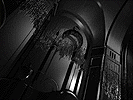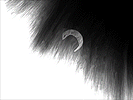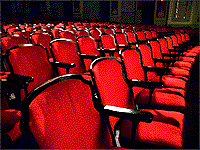 |

Visual Effects by
BANNED FROM THE RANCH ENTERTAINMENT |

|
For Artisan Entertainment's second creepy thriller of Fall 1999, writer/director David Koepp turned to Banned from the Ranch to help him generate supernatural chills. Koepp, the well-respected screenwriter of such films as DEATH BECOMES HER and the two JURASSIC PARKs, was obviously no stranger to the world of visual effects, but in bringing Richard Matheson's 1958 novel A STIR OF ECHOES to the screen, he had neither the budget nor the inclination to turn the legendary SF author's tale of ghosts and hypnosis into a flashy effects fest. In an essentially character-driven story, the visuals had to find that subtle balance between the obvious and the invisible.�

Visual effects supervisor Van Ling and digital artist Gunther Schatz teamed up for a pair of shots for the film's opening "hypnotism sequence," where black paint oozes down thw walls of a movie theatre. Using footage shot in a Chicago theatre, BFTR stabilized the shot, and modeled the walls in Alias without the use of any onset measurements. A series of 3D 'dripping' passes were created in Alias (bottom left), along with a mask (bottom right), and were then composited in After Effects.

 |
To this end, Koepp, cinematographer Fred Murphy and the BFTR team held a test shoot early in preproduction to determine the parameters and look of the ghostly effects. "There's this rich tradition of ghost effects that have been used in films, from transparency to light halos to objects floating around the room," notes BFTR effects supervisor Van Ling," and they define a visual shorthand that the audience can immediately grasp and say, 'oh, that's a ghost.' And every filmmaker who does a ghost movie immediately says 'I want to do something nobody's seen before, but I still want the audience to get it right away.' So we shot a whole series of tests against greenscreen, in which we played with camera speed and actor motion, and then tried a bunch of composites and things in the computer using the footage. What we found, of course, was that most of the time, making someone look "not of this plane" by setting them apart via lighting and motion often means they look composited into the shot! The lighting coming from the opposite direction from the rest of the shot, or using images superimposed over one another --these are all the things we normally strive to eliminate in order to make a shot look real and in-camera-- actually makes them look off, but not in a good way. In the end, what David liked the most was the more subtle speed tricks, where we shot her at 12 or 6 frames per second with as smooth a performance as possible. The other really cool idea, which evolved over the course of the shoot, was the idea of 'bilocation,' where Samantha would be several different places in the same shot."
For STIR, BFTR effects producer Casey Cannon took on the on-set supervising duties and traveled to Chicago for the duration of principal photography, while Ling remained in Los Angeles to work with the artists in dealing with some of vapor R&D and the incoming dailies (as well as the completion of effects work on a half dozen other BFTR projects). While the effects had been storyboarded, it was the on-set improvisations that lead to some of the most interesting and challenging shots. "We tried to make sure that during principal, we could give David as much flexibility as possible when it came to blocking the shots," said Casey. "We'd sometimes call Van in the middle of the night, while we were shooting, and discuss a spur-of-the-moment idea. It was never about why we can't do it; it was about figuring out how we could." In the spirit of Koepp's "95% normal, 5% weird" vision of the film, BFTR opted to have as much of the material shot in-camera as possible, with tracking and roto taking precedent over a lot of greenscreen or motion control.

Using After Effects and Photoshop, artist Josh Saeta made the theatre seats change color from red to black.
|
For the film's opening hypnosis sequence, in which the skeptical Tom Witzky (Kevin Bacon) is put under by his New Age sister-in-law Lisa (Illeana Douglas), the BFTR team led by Van and lead digital artist Todd Vaziri took the production footage shot in an old movie palace in Joliet, Illinois, and added the creeping blackness to it. To get the most value out of the footage, the production chose a single plate each of the wall and the seats, then flopped them to create a pair of separate shots, where the artists could alter the animation, but only have to do the roto work once. Digital artist Josh Saeta roto'd and animated the blackening of the red velvet seats in Adobe After Effects, while 3D artist Gunther Schatz began modeling work on what proved to be the toughest shots in the sequence. The theatre walls were intricately ornamented, with chandeliers, urns and plaster awnings, and David wanted them to literally look like black paint was flowing down the walls. Gunther tracked and generated the main wall geometry in Alias PowerAnimator, with only the footage itself as reference, since it had proven impossibleto get measurements on the detail of the three-story-high walls on location. Once created in the 3D realm, the walls were animated with a series of dripping texture maps created by Van. The resultant renders, complete with alpha channels and flowing specular highlights, were then brought into After Effects and composited, with Van tweaking the final levels of detail interaction using displacement maps and other elements created by Gunther. continued...


Banned From The Ranch Entertainment Home Page
����General Information: info@bftr.com
|

